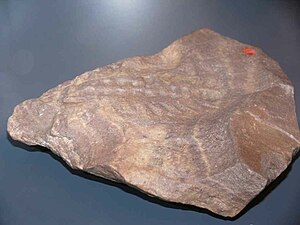Xenusion
| Xenusion | ||||||||||||
|---|---|---|---|---|---|---|---|---|---|---|---|---|

Type specimen of Xenusion auerswaldae in the Berlin Museum of Natural History |
||||||||||||
| Temporal occurrence | ||||||||||||
| Lower Cambrian | ||||||||||||
| 530 to 521 million years | ||||||||||||
| Systematics | ||||||||||||
|
||||||||||||
| Scientific name | ||||||||||||
| Xenusion | ||||||||||||
| Pompeckj , 1927 | ||||||||||||
| Art | ||||||||||||
|
Xenusion is a genus of extinct molting animals (Ecdysozoa) from the early Cambrian , around 530 to 521 mya . The two fossil specimensfound so farcome from the ice age debris in northern Germany . They are considered to be the oldest evidence of an animal with limbs . The only species ( type species ) is X. auerswaldae .
Systematic classification
Initially, the finds could not be assigned to any known animal group. Later they were placed among the lobopods (Lobopodia, Protarthropoda) living in the geological epoch of the Cambrian , which are probably closely related to today's colobus (Onychophora). However, recent forms of the Onychophora live on land. The fossils of xenusion probably come from the frühkambrischen marine deposits ( Kalmar sandstone ) located in Kalmar in Sweden pending .
Related forms (e.g. Hallucigenia ) have been found in the fossil fauna of the Canadian Burgess slate , a world-famous fossil deposit. As Microdictyon called spike-like skeletal elements of the small shelly fauna also one could Onychophoren -like fossil from the Cambrian of China ( Chengjiang -Fauna) are assigned.
Find history
Fritz Knuth found the first scientifically described specimen ( holotype ) when he was trenching his garden in Sewekow (now a part of Wittstock / Dosse ) in Prignitz . He handed it over to Annemarie von Auerswald , head of the “Heimatmuseum für die Prignitz” in the Stift zum Heiligengrabe monastery . She passed it on to Professor Josef Felix Pompeckj , Director of the Geological-Paleontological Institute and Museum of the Friedrich-Wilhelms-Universität (today Humboldt-Universität zu Berlin ) for scientific processing . It is the most important paleontological find in the Prignitz. The first find is now in the Berlin Natural History Museum .
Another specimen of Xenusion auerswaldae was found in 1978 by Helga and Horst Deichfuss on the island of Hiddensee and is in the geoscientific collections of the Martin Luther University Halle-Wittenberg , Institute for Geosciences.
swell
- ↑ Bruno Kernchen and Albert Guthke : Finder and Fundort des Xenusion auerswaldae , Prignitz-Forschungen, Vol. 1, 1966, pp. 13-17
- ↑ Joseph Felix Pompeckj: A new testimony to ancient life. , Paläontologische Zeitschrift, Vol. 9, 1927, pp. 287-313
- ^ H. Jaeger and A. Martinsson: Remarks on the problematic fossil Xenusion auerswaldae. , Geologiska Föreningens i Stockholm Förhandlingar, Vol. 88, 1967, pp: 435-452
- ↑ Günter Krumbiegel, Helga Deichfuss, Horst Deichfuss: A new find from Xenusion. Hallesches Jahrbuch für Geoswissenschaften, Vol. 5, 1980, pp. 97-99.
- ↑ Jerzy Dzik and Günter Krumbiegel: The oldest 'onychophoran' Xenusion: a link connecting phyla? , Lethaia 22 (2), 1989, 169-181